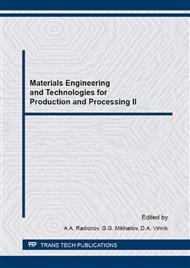[1]
V. Tyukavkina, A. Kasikov, F. Mayorova, B. Gurevich, Y. Neradovsky, Processing of copper and nickel waste slag to get silica-containing additives for binding materials, Ecology and Industry of Russia. 19 (2015) 13-17. (in Russ. ).
DOI: 10.18412/1816-0395-2015-11-13-17
Google Scholar
[2]
Information on http: /www. science-education. ru/ru/article/view?id=16435. (in Russ. ).
Google Scholar
[3]
J.F. Aukour, Incorporation of marble sludge in industrial building eco-blocks or cement bricks formulation, Jordan Journal of Civil Engineering. 1 (2009) 58-65.
Google Scholar
[4]
G.V. Kuznetsova, A lime binder for wall silicate products from chippings of rock crushing, Construction Materials. 12 (2014) 34-37. (in Russ. ).
Google Scholar
[5]
V.S. Gryzlov, A.I. Fomenko, N.M. Fedorchuk, N.S. Busygin, Kh. Kh. Turgumbaeva, I.Z. Lapshina, Electrothermophosphoric slags as a basis of binding composites, Construction Materials. 10 (2014) 66-69. (in Russ. ).
Google Scholar
[6]
A.N. Lukjanova, I.V. Starostina, Construction composite materials based on modified gypsum produced from waste production, Fundamental research. 4 (2013) 818-822. (in Russ. ).
Google Scholar
[7]
N.V. Chernysheva, The use of anthropogenic raw materials for increase of water resistance of a composite gypsum binder, Construction Materials. 7 (2014) 53-56. (in Russ. ).
Google Scholar
[8]
R.V. Lesovik, S.V. Klyuyev, Fiber concrete containing composite binders and technogenic sands of Kursk magnetic anomaly for flexural structures, Journal of Civil Engineering. 29 (2012) 41-47. (in Russ. ).
DOI: 10.5862/mce.29.5
Google Scholar
[9]
A. Yu. Stolboushkin, Influence of the wollastonite additive on the structure of wall ceramic materials from technogenic and natural resources, Construction Materials. 8 (2014) 13-17. (in Russ. ).
Google Scholar
[10]
A.A. Galenko, M.V. Pleshko, Ceramic tile for interior finishing of walls with the use of anthropogenic raw materials, Construction Materials. 7 (2014) 60-63.
Google Scholar
[11]
A. A Pykin, S.V. Vasyunina, A.A. Kalugin, A.A. Spodeneyko, Yu.A. Aver'yanenko, M.N. Aleksandrova, Improvement of efficiency of no-fines haydite concrete with nano-disperse additives, Construction Materials. 11 (2015) 20-23. (in Russ. ).
Google Scholar
[12]
Interstate standard 9758-2012, Non-organic porous aggregates for construction work, Test methods, Standartinform, Moscow, 2013. (in Russ. ).
Google Scholar
[13]
M.S. Lebedev, V.V. Strokova, S.V. Karatsupa, T.V. Dmitrieva, Designing of soil-concretes using the Kursk magnetic anomaly technogenic raw and waste-lime-based binder for reinforcing of road pavements subgrades, World Applied Sciences Journal. 30 (2014).
Google Scholar
[14]
S.P. Onatsky, Production of expanded clay, 3rd ed., Stroiizdat, Moscow, 1987. (in Russ. ).
Google Scholar
[15]
A. V Kolpakov, V.Z. Abdrakhimov, Study of heaving ratio and phase composition at various stages of slate clay baking, Building and reconstruction. 43 (2012) 50-56. (in Russ. ).
Google Scholar
[16]
B.S. Komissarenko, A.G. Chiknovoryan, S.A. Tokareva, Prospects for the development of expanded clay aggregates production and designs based on it, Construction Materials: Technology. 8 (2006) 14-16. (in Russ. ).
Google Scholar
[17]
V.Z. Abdrakhimov, Study of iron-containing traditional natural and technogenic raw materials on the sintering of ceramic materials, The influence of ions of Fe2+ and Fe3+ on the formation of low-temperature mullite, Samara SGS, Samara, 2009. (in Russ. ).
Google Scholar
[18]
V.Z. Abdrakhimov, K.V. Semyonychev, D. Yu. Denisov, Influence of ferriferous technogenic raw material of nonferrous machine industry on phase structure of a ceramic bar for floors, Bashkir chemical journal. 18 (2011) 144-146. (in Russ. ).
Google Scholar
[19]
I. Yu. Roschupkina, V.Z. Abdrakhimov, D. Yu. Denisov, Research of phase structure of expanded clay on the basis of waste of mountain-concentrating factory at coal enrichment, Bashkir chemical journal. 17 (2010) 136-138. (in Russ. ).
Google Scholar
[20]
V.Z. Abdrakhimov, V.A. Kulikov, I.V. Kovkov, Y.S. Abdrakhimov, The kinetics of the phase composition at different cooling rates of clay-based montmorillonite clay, Scientific Journal of Proceedings of the Samara Scientific Center of the Russian Academy of Sciences. 12 (2010).
Google Scholar


